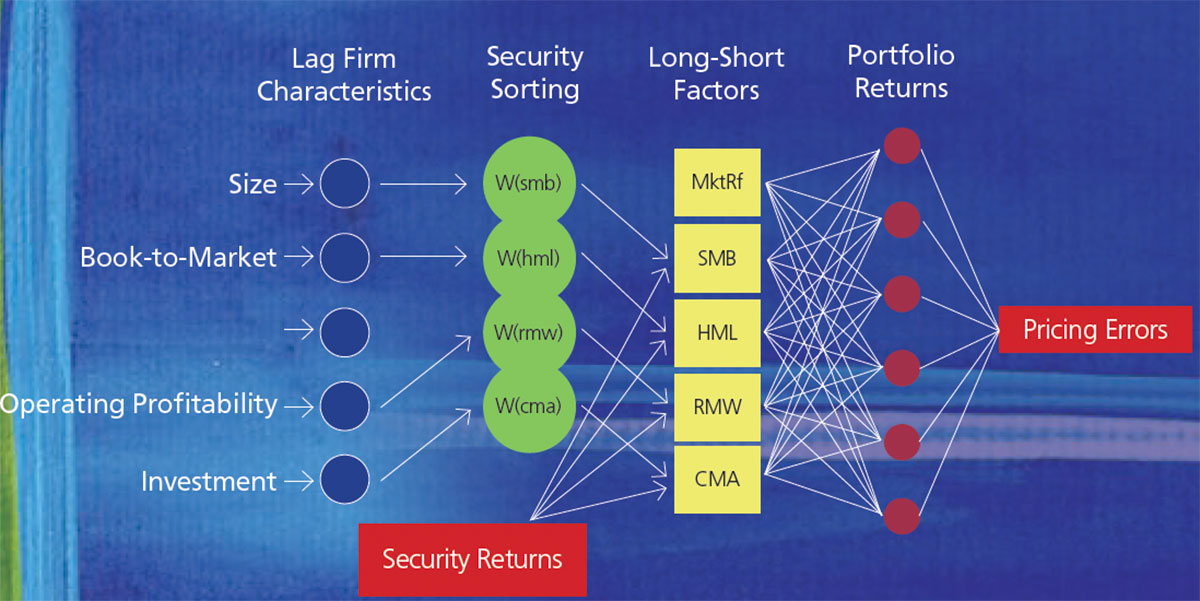Dr Gavin Feng is an Assistant Professor of Business Statistics at the Department of Management
Sciences. In this article, Feng focuses on the interdisciplinary research between deep learning and asset
pricing factor investing. The particular innovation is understanding the discovery and construction of asset
pricing factors with a bottom-up deep learning model. This article is based on his co-authored paper
"Deep learning in characteristics-sorted factor models" with Nicholas Polson and Jianeng Xu from the
University of Chicago.
Models for stock returns
include Nobel Prize
research such as the Capital
Asset Pricing Model and
the Fama-French 3-factor
model.
Asset pricing models study why
different assets attract different
expected returns. Examples of such
models for stock returns include
Nobel Prize research such as the CAPM (Capital Asset Pricing Model)
and the Fama-French 3-factor
model. In 2020, we present a
bottom-up approach based on deep
learning applied to the construction
of asset pricing models, which
include firm characteristics (inputs),
risk factors (intermediate features),
and security returns (outputs). The
question addressed using deep
learning, one special method
in machine learning, is how to
improve asset pricing models to
explain the cross-sectional average
returns.
According to ICAPM of Merton
(1973), a combination of common
tradable factors captures the crosssection
of expected returns, and the
regression intercept should be zero.
Ri,t = αi + β1,i ∗ 1,t + · · · + βk,i ∗ fk,t
+ Ei,t
Therefore, the model fitness for asset
pricing is not about the explained variation in time series, but the
magnitude of intercepts, alphas, in
the cross-section. This non-arbitrage
restriction on alphas implies that
simply adding factors leads to
statistical overfitting (time series
R2) but does not cause economic
overfitting (intercepts).
Researchers typically
sort securities on firm
characteristics and create
long-short portfolios as
common risk factors to
build asset pricing models.
In empirical studies, researchers
typically sort securities on firm
characteristics and create long-short
portfolios as common risk factors to
build asset pricing models. The goal
is to explain the time-series variation
of multiple asset returns and their
average returns' cross-sectional
variation. For example, Fama and French (1993) add SMB (small-minusbig)
and HML (high-minus-low) to
CAPM. However, in the asset pricing
literature, almost all proposed factor
models have rejected the zeroalpha
hypothesis. Therefore, we
want to approach this puzzle, with a
machine learning perspective, as an
optimisation problem: How does one
construct a factor model to minimise
pricing errors or alphas?
How does one construct a
factor model to minimise
pricing errors or alphas?
The goal of their paper is to
investigate the underlying
mechanism of the characteristicssorted
factor models, which includes
sorting securities, generating
factors, and fitting the cross section
of security returns. The particular
focus is the cross-sectional variation
of asset average returns. They
define an non-arbitrage objective
function, pricing errors, for the
optimization problem. They show
the characteristics-sorted factor
models can be dissembled as a deep
learning architecture (see Figure
above).
This figure provides a deep learning
representation of building the
Fama-French 5-factor model using
firm characteristics to calculate
the objective function, pricing
errors, for portfolio returns. The lag
characteristics are inputs. The longshort
factors are hidden neurons. The
portfolio returns are outputs.
(1) Inputs are firm characteristics. The neural network starts from sorting securities on firm characteristics, which is a non-linear activation to create long-short portfolio weights.
(2) Intermediate features are risk factors. The factors are linear activations (long-short portfolio weights) on realised returns from the sorting directions.
(3) Outputs are security returns. Minimising an economic objective function is equivalent to minimising pricing errors for fitting the factor model to portfolio or individual stock returns.
The focus is on "training
a factor model" rather
than "testing a factor or
characteristic."
Distinct from the literature on
stochastic discount factors, we
focus on training a factor model
rather than testing a factor or
characteristic. Apart from the PCA literature, their innovation is to
apply dimension reduction on firm
characteristics (inputs) rather than
the characteristics-sorted factors
(intermediate features). We argue
the current literature is mostly about
intermediate features and outputs
(security returns), whereas ours
illustrates the complete channel
between inputs and outputs. We
adopt a non-reduced-form neural
network and develop such a bottomup
approach that includes security
sorting, factor generation, and fitting
the cross-section of security returns.
The Fama-French-type characteristicssorted
factor models can be shown
as "shallow" learning models.
Dr Gavin Feng
Assistant Professor
Department of Management Sciences


